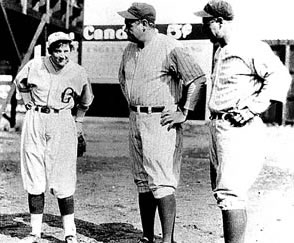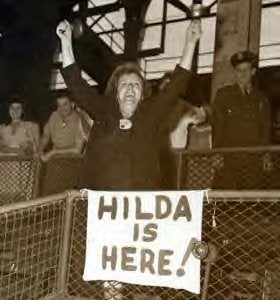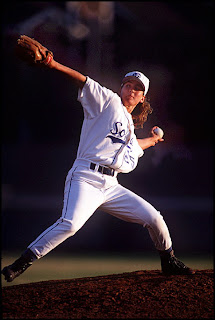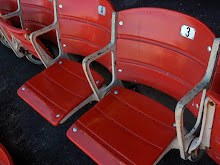If you don't know, now you know: March 8th marks International Women's Day. In its honor, this post is a salute to all of the incredible women in baseball history whose contributions are all too often forgotten. 
Joan Whitney Payson
Mets Co-founder and Original Owner, Team President 1968-1975
Joan Payson fell in love with baseball as a child watching the New York Giants at the Polo Grounds, and eventually became a minority shareholder in the team. After the Giants left for San Franciscio she sold her stock and began working to bring a replacement team to New York. In 1961, the National League awarded her a New York franchise, and from names including the Skyliners, the Burros, and the Jets, it was Joan Payson who picked the name Mets. She lobbied for the team to bring in her favorite players like Gil Hodges and Willie Mays and even convinced Casey Stengal to come out of retirement and become the team's first manager. Beloved by players and fans alike for her passion for the game, she could always be found in her box behind home plate cheering and even heckling the opposing players. In 1981 she was inducted into the Mets Hall of Fame.

First Young Ladies Baseball Club 1890
In the 1890s teams like the Young Ladies Baseball Club #1 barnstormed across America challenging men's local, semi-pro, and minor league teams. In spite of uniforms weighing upwards of 30 lbs, they were known to annihilate their male opponents.

Effa Manley
Newark Eagles Owner
Effa Manley was the owner and business manager of the Negro Leagues franchise the Newark Eagles. She was responsible for day-to-day business operations of the team, arranged playing schedules, planned the team’s travel, managed and met the payroll, bought the equipment, negotiated contracts, and handled publicity and promotions. Legend says she even called bunts from the stands by crossing and uncrossing her legs. Male owners She worked to improve playing conditions for her players, advocating better pay, scheduling, and travel accomodations. In the offseason, she sponsored a team in the Puerto Rican winter leagues to ensure her players had work opportunities. She provided the Eagles with an air-conditioned Flexible Clipper bus, a first for a Negro League Team. Aware of her team's role in the communitiy, Effa used baseball to advance civil rights. She worked with the Citizen's League for Fair Pay and the NAACP and in 1939 held an "Anti-Lynching Day" at Ruppert Stadium. In 2006 Manley became the first women to be inducted into the Baseball Hall of Fame. Her gravestone reads "She Loved Baseball."

Sophie Kurys
Second Base, Racine Belles 1943-1950
Known as "the Flint Flash," Sophie Kurys played second base for the Racine Belles of the All-American Girls Baseball League. In 1946 she was named Player of the Year when in 113 games she stole 201 bases in 203 attempts. No one in professional baseball has ever come close to that record, and Kurys had to do it in a skirt.
Mamie "Peanut" Johnson
Right-handed pitcher, Indianapolis Clowns 1953-1955
Rejected by the racially segregated All-American Girls League, Mamie Johnson went to play for the Indianapolis Clowns of the Negro Leagues. Afterwards she said "If I had played with white girls, I would have been just another player, but now I am somebody who has done something that no other woman has done." In her first game, an opposing batter yelled to the 100 pound pitcher, ""What makes you think you can strike a batter out? Why, you aren't any larger than a peanut!"" She responded by striking him out in 3 pitches and the nickname stuck with her from the day on.

Lizzie Murphy
Lizzie Murphy's baseball career began when she was 15, playing first base for local amateur teams. She moved up to play for the semi-pro Boston All-Stars, where she played in the same uniform as the men with one exception. Her name was written across the back and the front so that everyone could see she was the woman they came to see. In 1922 she became the first woman to play in a major league exhibition game. In 1928 she became the first person of either gender to play for both the National League and the American League in All-Star games.

Toni Stone
Second Base, Indianapolis Clowns and Kansas City Monarchs
After playing for several black semi-pro barnstorming teams, Toni Stone signed with the New Orleans Creoles, a team in the Negro League minors. In 1953, she was signed to play second base for the Indianapolis Clowns and became the first woman to play in the Negro Leagues. She played the 1954 season for the Kansas City Monarchs, but the Negro Leagues were coming to an end and she retired at the end of the season. Toni called facing Satchel Page her most memorable moment in baseball. "When he wound up--he had these big old feet--all you could see was his shoe. I stood there shaking, but I got a hit. Right out over second base. Happiest moment in my life."

Julie Croteau
In 1989 Julie Croteau became the first woman to play NCAA men's baseball. In her senior year of high school, Julie's parents filed a lawsuit against her school for not allowing her to play baseball. After she lost the case, the manager of the Fredricksburg Giants of the Virginia Baseball League invited her for a tryout and she earned a spot on the team. The next spring Croteau earned the starting second base position on the St. Mary's Seahawks. She told reporters she hoped her playing college ball would send a message to middle schools and high schools to allow girls to play. In 1994 she went on to play for the Colorado Silver Bullets and in 1995 she became the first woman to coach Division I baseball. She continues to work to make more opportunities available for women in baseball, and served as manager for the US Women's National team in the 2006 women's baseball world cup. Her glove and photo are displayed in the Baseball Hall of Fame.

Jackie Mitchell
Pitcher, Chattanooga Lookouts
In 1931, 17 year old Jackie Mitchell signed with the Southern Association AA Chattanooga Lookouts. On April 2nd the Yankees came to Chattanooga to play an exhibition game on their way back from spring training. On playing against a woman, Babe Ruth had this to say: "I don't know what's going to happen if they begin to let women in baseball. Of course, they will never make good. Why? Because they are too delicate. It would kill them to play ball every day." Ruth was the first batter Jackie faced and she struck out on four pitches. Infuriated and embarassed, he threw his bat and stormed back to the dugout. Next up Lou Gehrig swung and missed at three pitches in a row. A few days later the comissioner voided her contract, claiming baseball was "too strenuous" for a woman to handle. She travelled the country pitching in exhibition games and was retired by time she was 23, but the legend of those back to back strikeouts lives on.

Katie Brownell
On May 14th, 2005, 11 year old Katie Brownell pitched a perfect game for the little league Dodgers of Oakfield, NY, striking out every batter she faced. She was honoroed in a ceremony at the National Baseball Hall of Fame and donated her game jersey to become a part of the Women in Baseball exhibit.

Hilda Chester
"First Lady of Flatbush"
A former softball player, Hilda Chester became the Brooklyn Dodgers most famous fan. After she suffered a heart attack and her doctor forbid her from yelling at games, she started carrying a frying pan and ladle to Ebbets Field, making so much noise in the stands that all the fans and players noticed. In the late 1930s, the Dodgers honored her for her loyalty and presented her with a brass cowbell. Even after she was given a lifetime pass to the grandstand, Hilda and her bell could always be found among the rowdy fans in the bleachers.

Edith "The Kid" Houghton
First Female Major League Scout
Edith Houghton joined the Philadelphia Bobbies when she was only ten years old. In 1925 she travelled Japan with the Bobbies playing against men's college teams. When she returned home she played several seasons for Bloomer Girls teams and when World War II broke out she enlisted in the Navy's women's auxiliary and played for their baseball team. After the war she wrote to the owner of the Philadelphia Phillies asking for a job as a scout. She was hired and scouted for the Phillies for six years until she was called up for the Korean War.

Amanda Clement
Umpire
In 1904 Amanda Clement became the first woman to be paid to umpire a game. Amanda and her family travelled from South Dakota to Iowa to watch her brother pitch in a semi-pro game. When the umpire for an amateur game didn't show up, Amanda's brother said that she was a good ballplayer and could take his place. The semi-pro teams were so impressed they hired her on the spot and she umpired games for six years afterwards. In 1964 she was inducted into the South Dakota Hall of Fame.

Dorothy "Dottie" Wiltse
Pitcher, Fort Wayne Daisies
Dottie Wiltse was a pitcher for the Fort Wayne Daisies. In one month she twice won both games of doubleheaders. In each of her first four seasons, Wiltse won 20 games or more. She finished with a career record of 117-76 with an ERA of 1.83 and 1205 strikeouts, and in 1944 she pitched up until she was six months pregnant.

Ila Borders
Independent League Pitcher
In 1994 Ila Borders was the first female pitcher to start a men's NCAA or NAIA college baseball game with a complete game victory for Southern California College. After facing harassment from her SCC teammates, who threw balls at her head and slashed her tires, she transferred to Whittier College for her senior year. In 1997 she signed with the St. Paul Saints of the independent Northern League, where she was welcomed as just another ballplayer. One month into the season she was traded to the Duluth Superior Dukes, where she pitched through the 1999 season. In 2000 she for the Zion Pioneerzz of the Western Baseball League before retiring from baseball. She was inducted into the Baseball Reliquary Shrine of the Eternals in 2003.
Joanne "Joltin' Jo" Weaver
Joanne Weaver was the last professional baseball player to hit .400. In 1951, at age 14 Joanne followed her older sisters Betty and Jean's footsteps and played third base for the Fort Wayne Daisies of the All-American Girls Professional Baseball League. In 1952 and 1953 she won back to back batting titles. In 1954 she had a season average of .429 with 29 home runs, 254 total bases, 87 RBI, 16 doubles, 4 triples, 79 stolen bases and 109 runs scored. No player had a higher batting average in the entire 20th century.

Lady Met
Mascot extraordinaire.
Unlike her male counterpart, we don't think she gets nearly enough play.






 Every reminder of the heartbreak of last season turning to smoke was a beautiful sight. I feel like the demons of 2007 have finally been vanquished and I can move on. In just a few short hours I'll be out watching Johan Santana's very first start real start as a Met. After the winter that felt like it would never end the 2008 season is finally upon us. The past's the past, today we start new.
Every reminder of the heartbreak of last season turning to smoke was a beautiful sight. I feel like the demons of 2007 have finally been vanquished and I can move on. In just a few short hours I'll be out watching Johan Santana's very first start real start as a Met. After the winter that felt like it would never end the 2008 season is finally upon us. The past's the past, today we start new. 



















































 I probably had the best time watching a bunch of the young pitchers take batting practice. They all went nuts when someone would get a big hit. Matt Wise was imitating someone's swing and told everyone "I am going to tell that story everyday because it was the funniest thing I've ever seen in my life." And then when they went to clean up the balls, the Big Pelf decided to push Jason Vargas in a shopping cart across the field.
I probably had the best time watching a bunch of the young pitchers take batting practice. They all went nuts when someone would get a big hit. Matt Wise was imitating someone's swing and told everyone "I am going to tell that story everyday because it was the funniest thing I've ever seen in my life." And then when they went to clean up the balls, the Big Pelf decided to push Jason Vargas in a shopping cart across the field.


 My favorite part of spring training is getting a first look at the players while they're still young and excited to be there. Eddie Kunz, who is a giant in person, was running to his next workout but turned aroung to sign for us when he heard his first name. Later I sent the little sis running up to Brant Rustich yelling "Brant, we love you!" He got a good laugh from that one. It's just the truth, Brant. You're a Met now so you should get used to hearing it. Some of the guys we'd seen play for the Cyclones last year so it was exciting to see playing with all the big stars.
My favorite part of spring training is getting a first look at the players while they're still young and excited to be there. Eddie Kunz, who is a giant in person, was running to his next workout but turned aroung to sign for us when he heard his first name. Later I sent the little sis running up to Brant Rustich yelling "Brant, we love you!" He got a good laugh from that one. It's just the truth, Brant. You're a Met now so you should get used to hearing it. Some of the guys we'd seen play for the Cyclones last year so it was exciting to see playing with all the big stars.







 We watched the Mets/Braves game from out on the berm, which was great for the experience (even though at one point a stroller came crashing on my head) and because it gave us a great view of Fernando Martinez. I'd been trying not to get too attached to the kid over the winter for fear he'd get traded, but now there's no reason not to be excited for his future. Pelfrey was looking strong and pitched 3 shutout innings. Once again the Mets made things dramatic with Michel Abreu scoring on a Ruben Tejada double in the 10th to win it 3-2.
We watched the Mets/Braves game from out on the berm, which was great for the experience (even though at one point a stroller came crashing on my head) and because it gave us a great view of Fernando Martinez. I'd been trying not to get too attached to the kid over the winter for fear he'd get traded, but now there's no reason not to be excited for his future. Pelfrey was looking strong and pitched 3 shutout innings. Once again the Mets made things dramatic with Michel Abreu scoring on a Ruben Tejada double in the 10th to win it 3-2.


